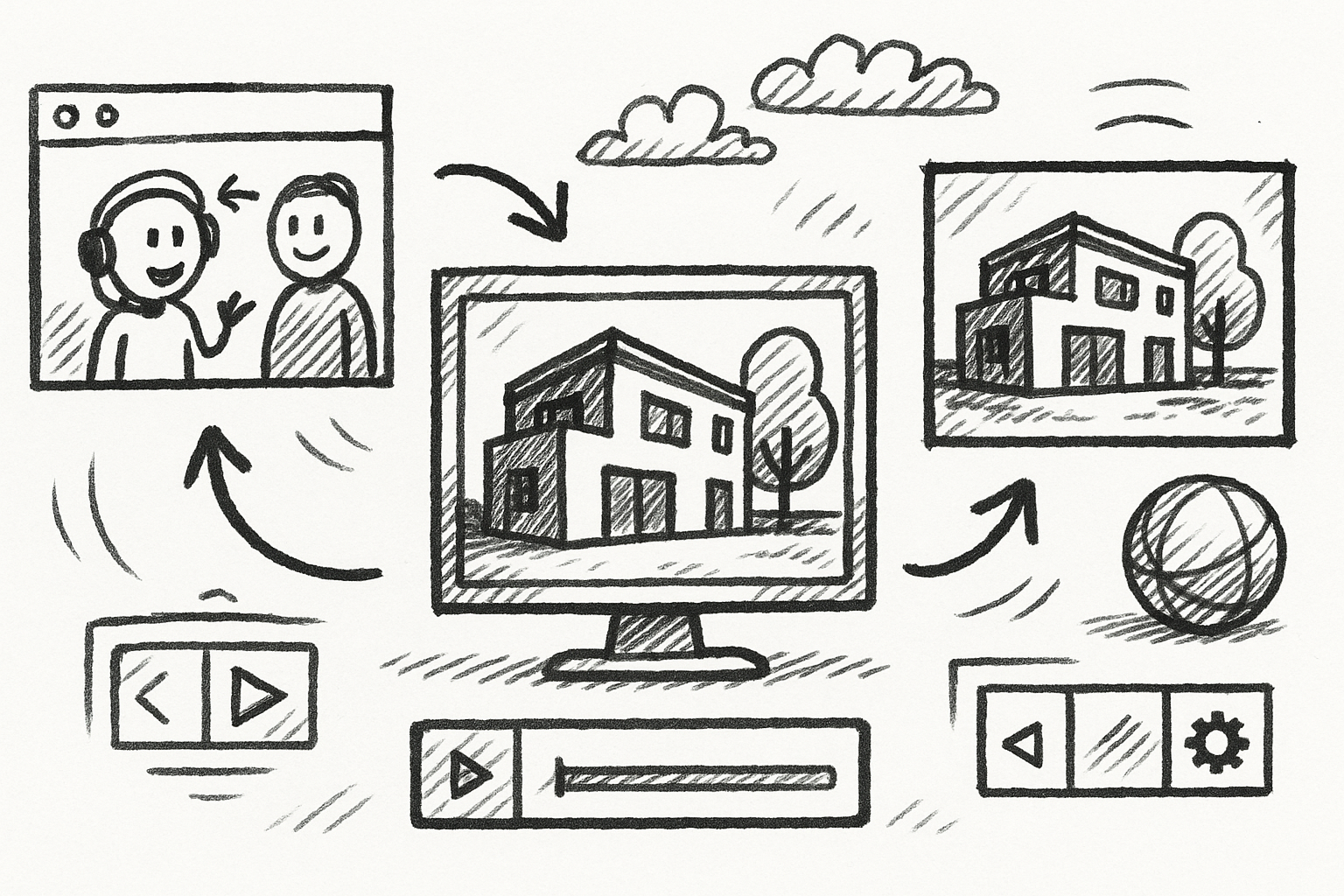Your Cart is Empty
Customer Testimonials
-
"Great customer service. The folks at Novedge were super helpful in navigating a somewhat complicated order including software upgrades and serial numbers in various stages of inactivity. They were friendly and helpful throughout the process.."
Ruben Ruckmark
"Quick & very helpful. We have been using Novedge for years and are very happy with their quick service when we need to make a purchase and excellent support resolving any issues."
Will Woodson
"Scott is the best. He reminds me about subscriptions dates, guides me in the correct direction for updates. He always responds promptly to me. He is literally the reason I continue to work with Novedge and will do so in the future."
Edward Mchugh
"Calvin Lok is “the man”. After my purchase of Sketchup 2021, he called me and provided step-by-step instructions to ease me through difficulties I was having with the setup of my new software."
Mike Borzage
Revolutionizing Visualization: V-Ray's Real-Time Collaboration and Advanced Rendering Techniques
May 16, 2025 5 min read


Until recently, directors and supervisors tolerated a habitual lag between 3D intent and on-screen evidence. V-Ray’s newest feature set has redrawn that tolerance line. By fusing near-instant visual feedback with policy-driven resource scaling, the renderer now feels less like a detached finalizer and more like an always-present collaborator. Pipeline conversations are shifting from “when will we see it?” to “how far can we push it?”.
Real-Time V-Ray Vision & Interactive Rendering
The debut of V-Ray Vision and an overhauled Interactive Production Renderer refactors the very first phase of a shot: exploration. Vision hands artists a live viewport that streams fully shaded frames at game-engine cadence, while the IPR engine inherits deeper core parity with final-quality ray tracing. The practical delta is enormous—scene layout, camera choreography, and material dialing no longer sit behind the wall of test renders.
- Live viewport feedback exposes light color shifts or subtle texture tiling issues the moment a slider moves.
- Motion path edits can be scrubbed in real time, so animators immediately know whether parallax or focal length reads correctly.
Continuous WYSIWYG confidence eliminates the traditional cadence of “prep → queue preview → coffee break → evaluate → iterate.” Iterations collapse into seconds. A lighter hardware footprint, courtesy of aggressive level-of-detail trimming and cached textures in Vision, means art directors can conduct shoulder checks on a laptop without waiting for the dailies round trip.
Expert tip: After initial blocking, copy the Vision presets into the production render settings profile. Matching GI engine, bucket size, and denoiser choices early on prevents aesthetic mismatches that surface only at 4K delivery.
Next-Gen GPU Acceleration & Hybrid Rendering
The renderer’s GPU rewrite is more than a version bump; it is a philosophical shift toward egalitarian hardware use. CUDA and RTX cores now chew through shading graphs in a bucketless progressive mode that never stalls on complex BRDFs. Should VRAM saturate, seamless CPU fallback keeps buckets flowing rather than killing the render. Production benchmarks published by studios report frame times slashed by 40–70 %, even on hero shots dense with instanced foliage and volumetric fog.
Performance uniformity across stills and sequences offers two vital benefits. First, editorial can see near-final pixels during blocking passes, freeing them to lock cut length and pacing earlier. Second, producers can predict render budgets with real data rather than spreadsheet folklore.
Many facilities now schedule:
- GPU nodes for real-time dailies and animatic approvals.
- CPU blades—often older machines repurposed—for deep-focus, high-sample finals where VRAM limits once disqualified GPU use entirely.
Expert tip: Profile VRAM consumption with the V-Ray Profiler. If a pyro cache or ocean mesh spikes memory, shift it into an isolated pass. The hybrid engine can then multiplex lighter elements on the GPU while letting CPUs crunch the heavy FX layer in parallel.
Chaos Cloud One-Click Batch Rendering
Elastic compute is no longer a luxury; episodic streaming schedules demand it. Chaos Cloud removes the friction traditionally associated with spinning up a rented farm. By clicking “Submit to Cloud,” the DCC package exports a standalone .vrscene, packages supporting textures, checks for plugin versions, and uploads everything in one transactional handoff. From that moment on, machine provisioning, instance teardown, and cost tracking live in a single web console.
This frictionless model unlocks two workflow maneuvers previously reserved for studios with on-prem racks:
- Overnight high-resolution finals without tying up local GPUs needed for daily look-dev.
- Parallel variant rendering—alternate lighting rigs, grade passes, or geometry versions can be farmed concurrently rather than sequentially.
Budget forecasting turns into a simple multiplication of per-frame cost by shot length. Producers gain a real-time readout of spend, aligning naturally with bursty production phases where the last two weeks before delivery balloon from ten active shots to a hundred.
Expert tip: Use the V-Ray Standalone exporter to produce lean .vrscene files stripped of host-specific overhead. Smaller payloads upload faster and avoid redundant data transfer fees.
Adaptive Dome Light & Smart Sampling for Flicker-Free GI
Global illumination has long been the double-edged sword of photorealism: essential for believability yet prone to temporal artifacts once a camera starts moving. V-Ray’s adaptive dome light now employs machine-learning heuristics to steer rays toward the most influential texels of an HDRI, effectively removing 30 % of the brute-force cost. Coupled with smarter irradiance caching, the renderer no longer blossoms into splotches when sunlight grazes a grazing surface or a glossy bounce ripples across a water plane.
The headline is flicker-free sequences out of the box. Artists can drop a single-frame HDRI setup at layout time and trust it through final delivery without per-shot gymnastics. The trickle-down effects include smaller Q/A budgets, fewer late-night re-renders, and lighter compositing since the plate arrives free of GI noise.
Expert tip: Once a noise threshold passes client review, lock the adaptive sampling values. Consistent thresholds across every frame guarantee that denoising behaves uniformly, eliminating the dreaded “boiling shadows” syndrome.
ACEScg & Light Mix for Post-Friendly Color Control
Color management leaps forward with native ACEScg processing inside the frame buffer. Instead of baking a quasi-linear approximation, the renderer runs internal math in the wide-gamut ACEScg primaries and derives display-referenced views on the fly. The result is a physically grounded color pipeline whose pixel values map one-to-one from HDR workstation monitors to Dolby-Vision grading suites.
Parallel to the gamut expansion, Light Mix arrives as an interactive relighting layer embedded into the VFB and exposed as metadata in compositing packages such as Nuke. Each light in the scene contributes a separable render element whose intensity and hue can be modified after the fact—no re-render required.
The creative latitude is enormous:
- A supervisor may pivot the key light from warm sunset to cool moonlight during the grade without looping back to 3D.
- LUTs and exposure tweaks can be explored non-destructively because ACEScg headroom prevents channel clipping.
Because Light Mix adjustments resolve as metadata rather than baked pixels, iteration files remain lightweight. A turntable that once spawned dozens of 16-bit EXRs now travels as a single EXR plus a compact .json sidecar describing intensity coefficients.
Expert tip: Before shot hand-off, bake the approved Light Mix into a dedicated “beauty_baked” pass. This locks supervisory decisions and prevents late-stage drift when the comp team cascades additional color corrections.
Conclusion
Collectively, these five advances convert V-Ray from a deterministic but time-hungry renderer into an adaptive, dialogue-driven partner. Real-time feedback slashes guesswork at the artist’s desk. Elastic compute quiets the perennial fight for farm slots. Intelligent sampling lifts final pixels free of noise faster than brute force ever could. The synergy compresses schedules while simultaneously lifting the ceiling on visual fidelity.
Studios contemplating where to invest next should map these capabilities onto pain points already felt on the floor. Incremental adoption—Vision for look-dev, GPU for dailies, Cloud for finals, adaptive GI for animation, and ACEScg for color—delivers immediate, measurable returns without wholesale pipeline upheaval. In an industry where client expectations evolve monthly, the only sustainable answer is a renderer that evolves daily, and V-Ray’s current toolkit embodies that mandate.
Also in Design News

Bluebeam Tip: Standardized Punch-List Workflow in Bluebeam Revu
December 31, 2025 2 min read
Read MoreSubscribe
Sign up to get the latest on sales, new releases and more …




